Artists
Rising Star Amy Bravo Sold Out Her New Solo Show. What’s Behind Her ‘Grandma’s House’ Art Installation?
The exhibition is the first staged by Swivel Gallery following their announced move from Brooklyn to Manhattan.
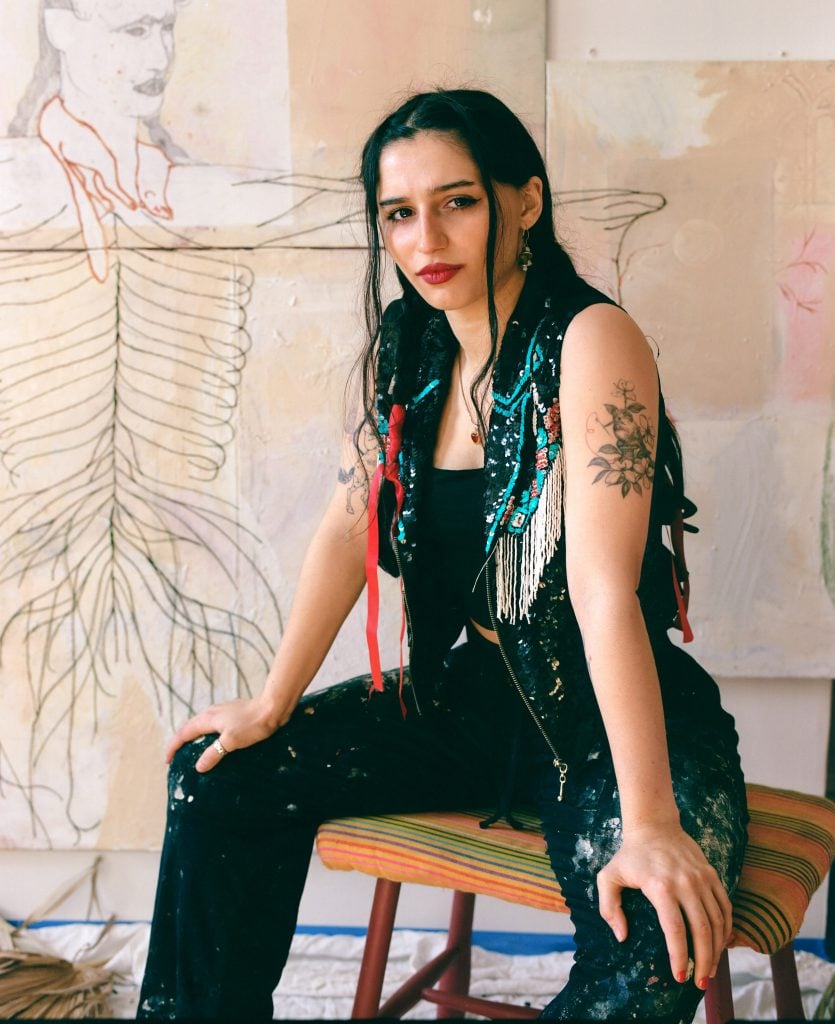
The exhibition is the first staged by Swivel Gallery following their announced move from Brooklyn to Manhattan.

Annikka Olsen

Swivel Gallery burst onto the New York art scene in 2021, helmed by Graham Wilson and housed in the former Restoration Tabernacle church in the Brooklyn neighborhood of Bed-Stuy. Operating as an incubator for emerging talents, the gallery’s success necessitated an expansion and move in 2023 to East Williamsburg. Recently, the gallery announced a new chapter in its history, as Swivel has made the jump across the East River to 555 Greenwich Street in Manhattan’s Hudson Square.
“Our gallery really started from the bottom,” said Wilson of the move, “and we have, with the help of our artists whom I believe are some of the most incredible people working at this time, really built it into a viable contender in this microcosm society that we all take part in. I felt that it was time that after a long few years and a hard push in Brooklyn, I took them to a bigger platform.”
According to Wilson, there were two main factors that influenced the big move, the first being the visibility that comes from proximity. Adjacent to the thriving Tribeca gallery scene and just a few stops from the established Chelsea Arts District, Swivel Gallery is primely situated for a larger audience. And second the new space offers the chance to dig deeper into the gallery’s mission. Wilson said, “our new space will allow us to revert to a hyper-focused schedule of solo or two person exhibitions that we believe is important to showing the vision of the gallery, one that is extremely diverse in mediums as well as in backgrounds.”
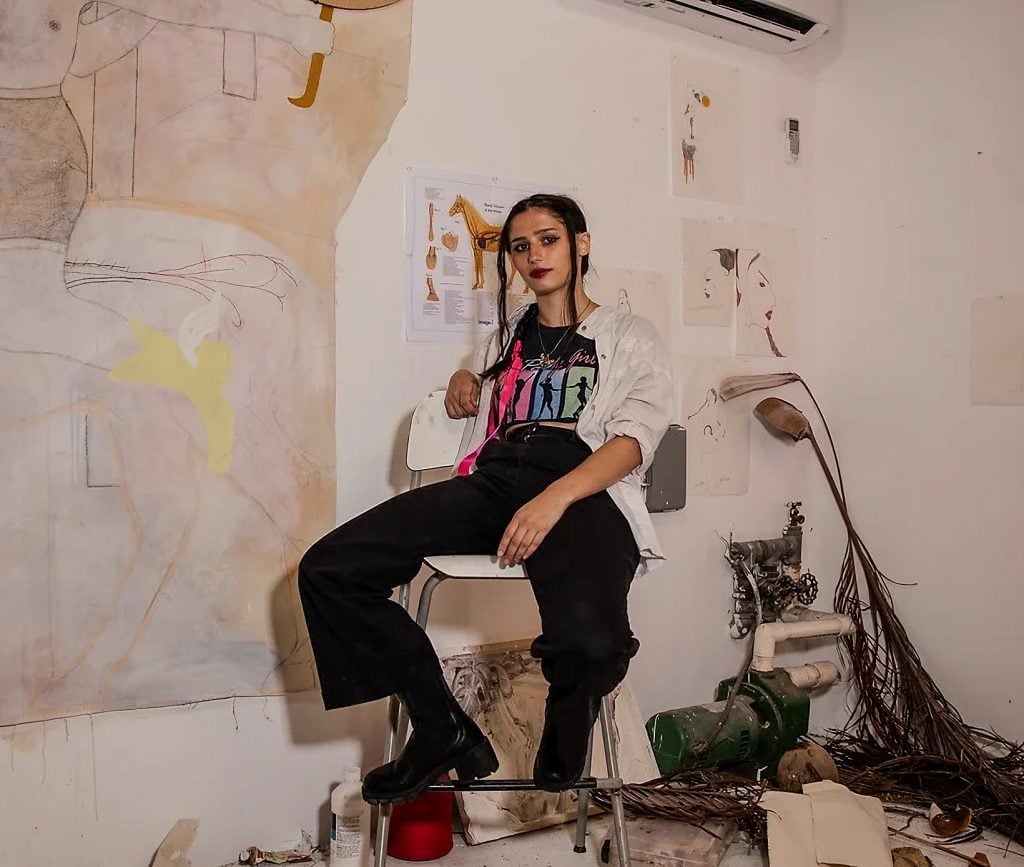
Amy Bravo. Courtesy of the artist and Swivel Gallery.
The solo exhibition “Amy Bravo: TransmogrificationNow!” is Swivel Gallery’s inaugural Manhattan-location show—well, almost. Construction delays in the new space required some quick thinking, and Bravo’s show is staged one block away in a temporary space at 350 Hudson Street, but that has worked out just fine for Bravo.
“I always wanted to do a more immersive installation, and when we found out about the delay and we were given this raw space, we thought ‘well we have to build walls anyway,’ so it was really a kind of a perfect opportunity,” said Bravo from inside the show.
Currently a resident of the International Studio and Curatorial Program, the present exhibition marks Bravo’s third solo this year, with the previous two taking place in Milan and Paris respectively. Further testament to her rising status as the sought-after artist of the moment, her show at Swivel Gallery is already completely sold out.
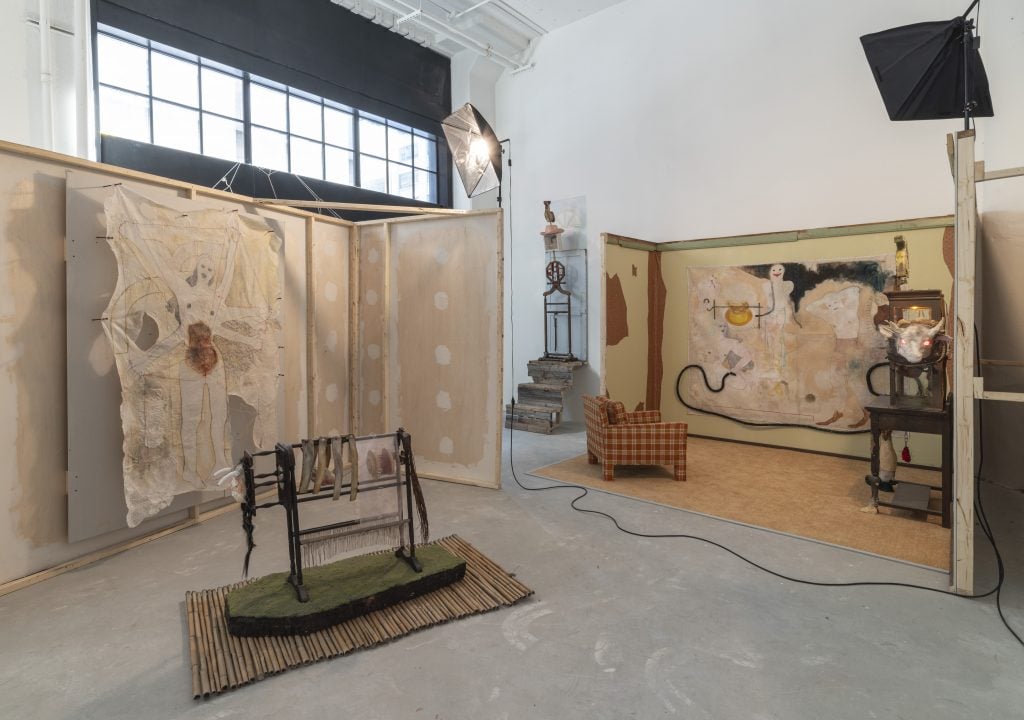
Installation view of “Amy Bravo: TransmogrificationNow!” (2024). Photo: Cary Whittier. Courtesy of Swivel Gallery.
Bravo certainly took full advantage of the blank slate she was presented with for “TransmogrificationNow!” Inside, the artist has brought to life spaces from her grandparent’s house, replete with a full-scale living room. Throughout, no surface is neutral, with swathes of brick, clapboard, linoleum, wallpaper, and even carpeting in that very specific shade of 1970s orange evoke the feeling of being ensconced in an elderly relative’s home. “We were very intentional [creating the space] and it was quite hard to find certain things, like the wallpaper was such a task to find. Nobody’s making stuff ugly-grandma style anymore,” said Bravo.
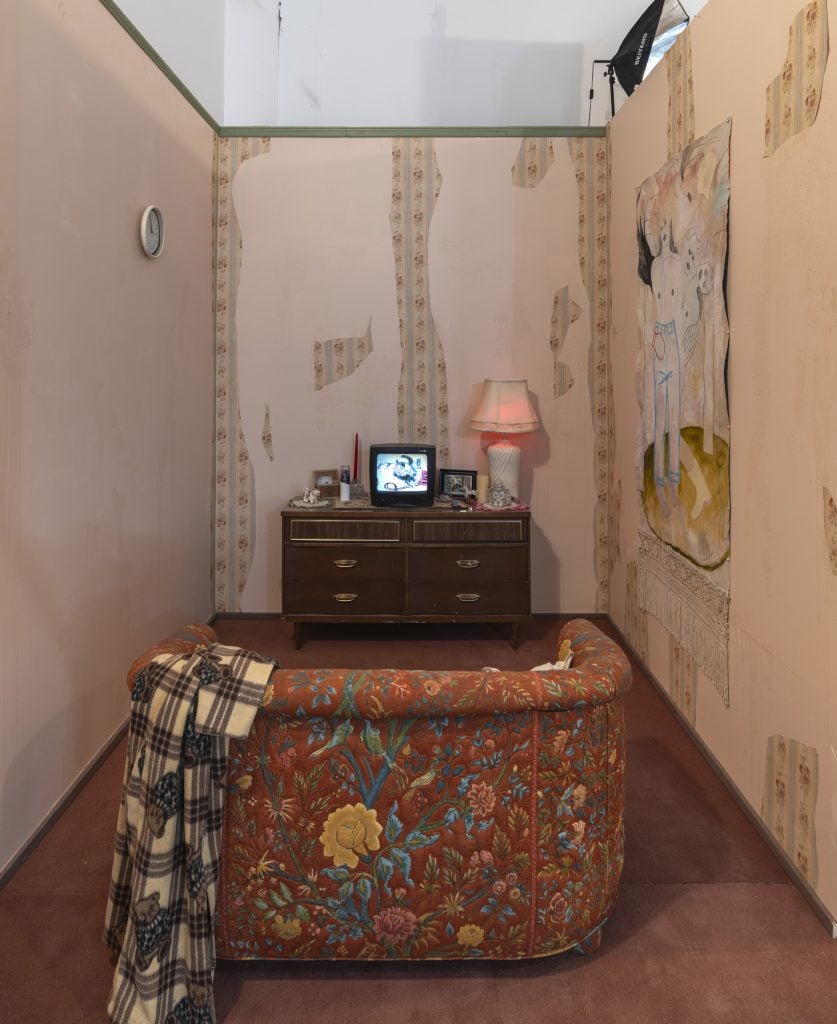
Installation view of “Amy Bravo: TransmogrificationNow!” (2024). Photo: Cary Whittier. Courtesy of Swivel Gallery.
The show speaks to Bravo’s interrogation of identity, heritage, and familial history. One that, like many, is riddled with both missing information and information one wishes that perhaps they could change. Originally from New Jersey and now based here in New York, Bravo is of Italian-Cuban descent, and the artist’s family and history loom large in her practice. Both grandmothers, one Italian and one who emigrated from Cuba pre-revolution, were seamstresses who worked in sweatshops in the city’s Garment District, a fact that has influenced Bravo’s engagement with textiles in her work.
“Reconciling that history, every time I work with embroidery or fabric, it feels like an homage to them, even though I never learned how to properly sew or use the machine, really. Everything has this scraped together, hand-sewn quality, which is almost embarrassing, in the same way that I can’t speak Spanish feels embarrassing.”
Bravo’s technical approach is highly visible in her paintings, and penchant for incorporating textile wherever possible most apparent. Working on unstretched canvas, pieces are cut out of one piece and stitched to another, compositions are rotated, and frequently don’t sit totally flush with the wall. Much of what is on the surface of the canvas isn’t paint at all, but instead graphite, wax pastel, or epoxy, sometimes with lace, webs of crochet, or a series of steel nails added for effect. She cites Cuban artist Belkis Ayón as a major influence, specifically the way Ayón’s paintings engage with space and aren’t always confined to the flat wall, similar to how Bravo’s use of mixed media challenges the very notion of what painting can be.
“It gives you so much freedom. I can’t with a stretched canvas. The corners become so important. I feel like I’m filling a container and it’s so precious.” “When you have an unstretched canvas, it’s infinitely changeable. You can cut it up, sew another piece on, flip it around—it gives you this complete and dynamic relationship to the surface you’re working on.”
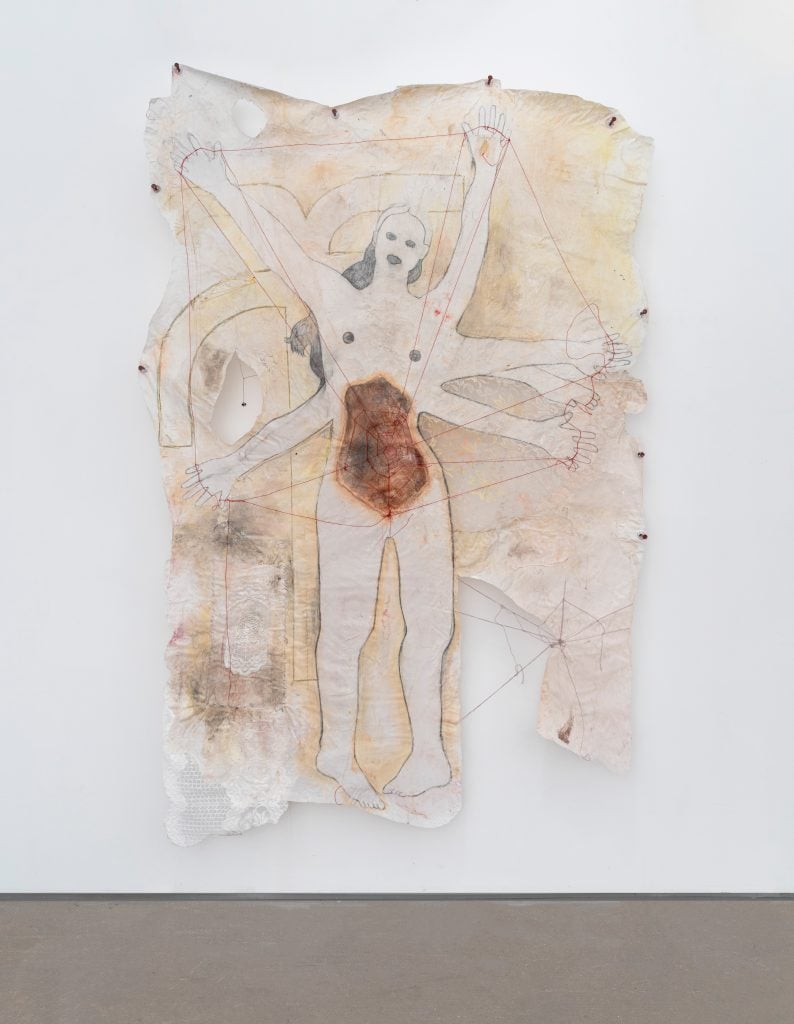
Amy Bravo, Silk Tosser (2024). Courtesy of Swivel Gallery.
In pieces like the self-portrait Silk Tosser (2024), overlaying the six-armed figure is a spider web of red thread, and where portions of the canvas have been cut away, they’ve subsequently been mended with patches of white lace. Wrapped around the figures fingers and centered over a gapping void in their abdomen, the web can be understood as a metaphor for the artist’s practice as well as personal journey reconciling and weaving together fragmented histories.
“I’m trying to engage with [my grandparents’] stories and their lives, like a fly on the wall of something that doesn’t even exist anymore. I’m trying to get a glimpse of something that’s rapidly dissipating. The need to preserve it for some reason is very important to me, but it’s like a game of telephone, and it won’t ever stay the same. It won’t ever be true to their actual lives.”
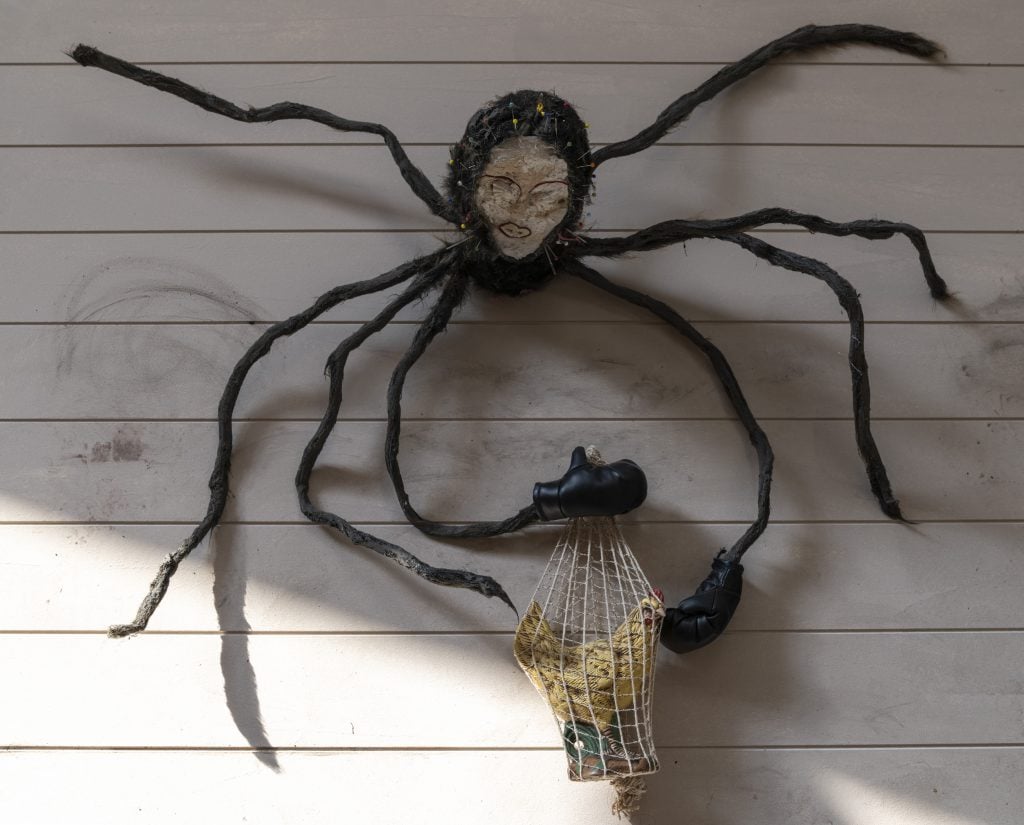
Installation view of “Amy Bravo: TransmogrificationNow!” (2024). Photo: Cary Whittier. Courtesy of Swivel Gallery.
Spider webs and spiders are recurring motifs throughout the show, including several spider sculptures that are installed high on the walls and peer down into the show, a proverbial stand in for the artist carefully creeping through her own and family’s history, relegated to the corners of memory. Roosters too appear regularly, a symbolic reference generally the machismo culture and specifically the male figures in Bravo’s family. In Trojan Rooster (Day Stalker) (2024), the depiction of Bravo is contained in an outline of a rooster, alluding to her own relationship with men and maleness.
“Instead of reaching for objects that are in the room, I reach for symbols and motifs that are being built in my world. It’s like I have this curio cabinet of motifs that I pull from into the painting and then things will happen that I didn’t expect.”
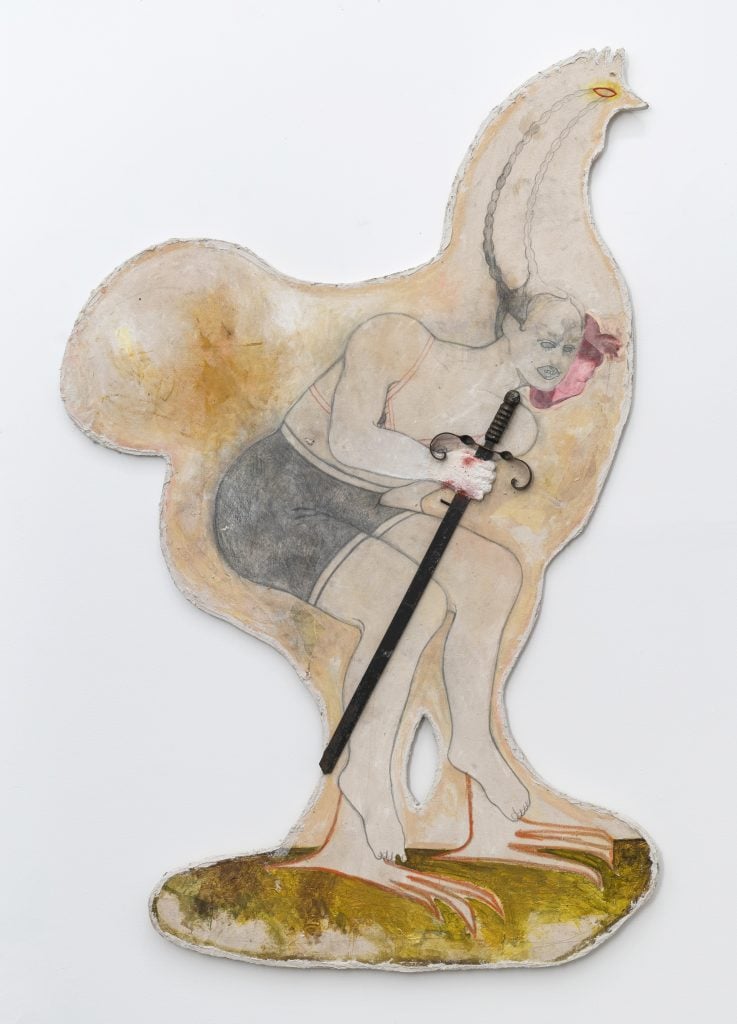
Amy Bravo, Trojan Rooster (Day Stalker) (2024). Courtesy of Swivel Gallery.
Curio cabinets, both metaphoric and real, are a potent source of inspiration and creative starting point for Bravo. Recalling childhood memories playing with the objects in the curio cabinets kept by people in her family, her cabinet-based sculptures seem to have appeared out of a fairy tale. Some with limbs or faces or hair, Bravo has made the curio cabinet a character whose story is told through the assortment of objects it holds. Automaton 40 (Bull-Remastered) (2024), a pair of boxing gloves covered in ball-point pins are references to her father and grandfather who were boxers, with the pins balancing the masculine connotation with the feminine connection to sewing, seamstresses, and her grandmother. Their construction brings to mind the work of Betye Saar and Louise Bourgeois, and their decisive use of symbolism alludes to the deeply personal mythology of the artist while remaining open ended enough for viewers to bring their own.
“I am very conscious of the fact that most of the context of my work is not immediately readable,” said Bravo. “You’re not going to know this figure means this, so what I wanted to do in the presentation of the work is provide that context through the setting. The grandmother’s home setting. If you see these works without that, you might just think they’re about femininity, about power, which they are. But I think it’s also through the lens of family struggle. Adding that gives another element for the viewer to get a deeper sense of where the work is coming from, where each figure is coming from.”
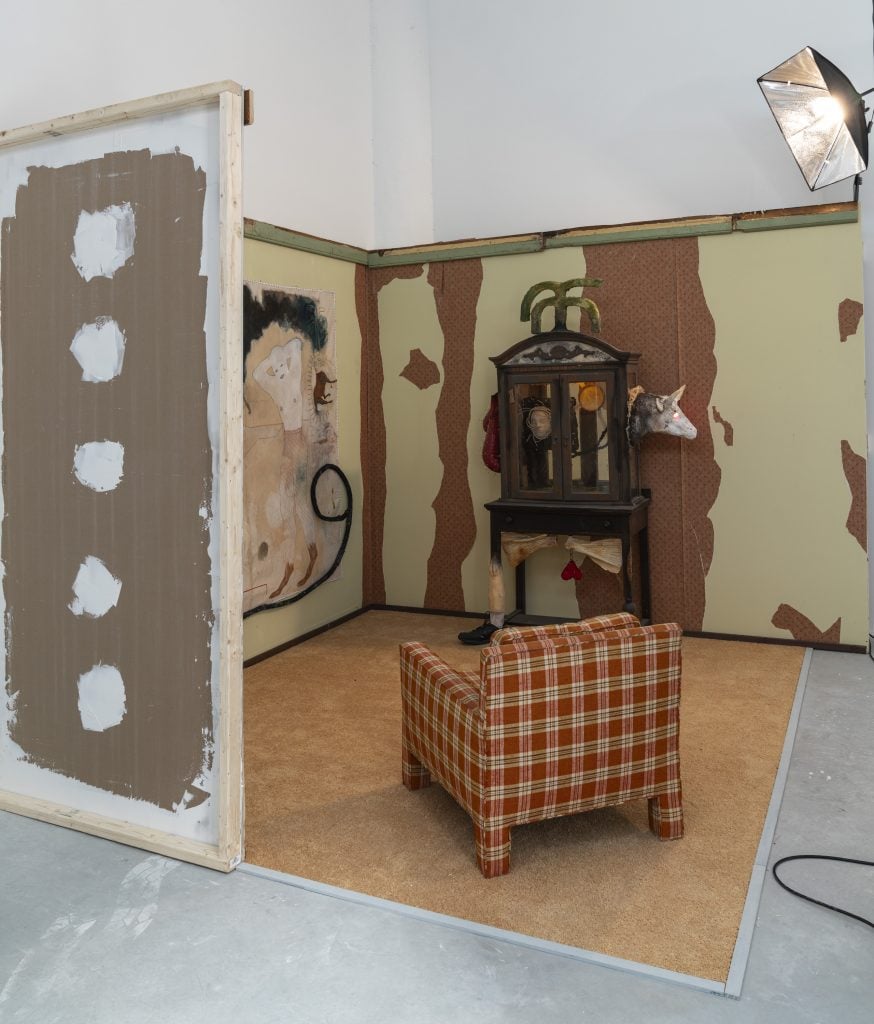
Installation view of “Amy Bravo: TransmogrificationNow!” (2024). Photo: Cary Whittier. Courtesy of Swivel Gallery.
While the individual works within “TransmogrificationNow!” offer insight into Bravo’s singular artistic vernacular and world building, the power of the installation on the whole cannot be understated, as it offers an experiential entryway, almost portal, for the viewer. Though created with her memories and experiences in mind, an element of the universal saturates the show; the slightly awkward, uncomfortable feeling of being in an elder’s home, where what can and cannot be touched is nebulous, “overhearing something you’re not supposed to hear,” and where even everyday objects like a doily or figurine have an air of the precious. The grandmother’s living room is transformed into a type of liminal space, one encountered by many if not most, and speaks to the discomfort Bravo mines in her work.
“I think [my work] does a lot of healing for me, it’s a place to put anger that you don’t need to put on other people, and you don’t need to put into your life. And it’s a place to put your own complexes. They fall into the work, and I can alchemize them into power through the work.”
Swivel Gallery’s space at 555 Greenwich Street will open October 26, 2024.